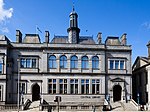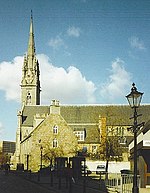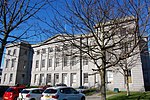County Buildings, Aberdeen
Category B listed buildings in AberdeenCounty halls in ScotlandGovernment buildings completed in 1896Use British English from December 2022

County Buildings is a municipal structure in Union Terrace, Aberdeen, Scotland. The structure, which was the headquarters of Aberdeenshire County Council and was later converted for commercial use as Denburn House, comprises three separate structures all of which are Category B listed buildings.
Excerpt from the Wikipedia article County Buildings, Aberdeen (License: CC BY-SA 3.0, Authors, Images).County Buildings, Aberdeen
Union Terrace, Aberdeen City City Centre
Geographical coordinates (GPS) Address Nearby Places Show on map
Geographical coordinates (GPS)
| Latitude | Longitude |
|---|---|
| N 57.1469 ° | E -2.1049 ° |
Address
Wallace Statue
Union Terrace
AB10 1NP Aberdeen City, City Centre
Scotland, United Kingdom
Open on Google Maps









